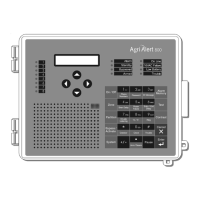What to do if the LOW BATTERY LED turns on when electrical power is OK in Agri Alert Security System?
- SSteven Hill MDAug 8, 2025
If the LOW BATTERY LED on your Agri Alert Security System is illuminated while electrical power is okay, remember that the reset time is 45 minutes, and the counter starts when the display backlight turns off. Begin by checking the battery voltage by pressing the System key and selecting BACKUP BATTERY from the Program Aux's menu; the normal voltage should be between 12V and 14V. Also, check fuse F28, and if it's blown, determine the cause before replacing it, ensuring you do not increase the fuse capacity to avoid a fire hazard. Inspect the wall transformer and wiring, using a voltmeter to confirm a minimum of 16VAC at the 16VAC input terminals, and verify the wiring to the battery. If the issue persists, contact your dealer.

